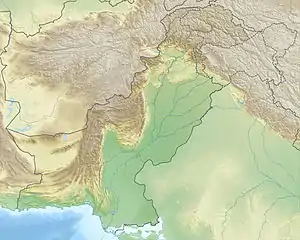Takht-e-Sulaiman
Takht-e-Sulaiman (Pashto: تخت سليمان، د کسي غر), or Throne of Solomon, is a peak of the Sulaiman Mountains, located near the village of Darazinda in Frontier Region Dera Ismail Khan of the Federally Administered Tribal Areas of Pakistan.[1] It is close to Frontier Region Dera Ismail Khan's borders with both South Waziristan and Zhob, Balochistan. At 3,487 metres (11,440 ft), it is the highest peak in Frontier Region Dera Ismail Khan and the greater Shirani region.[1] Ibn Battuta named Takht-e-Sulaiman as Kōh-e Sulaymān, "Mount of Solomon".[2][3]
| Takht-e-Sulaiman | |
|---|---|
 Takht-e-Sulaiman | |
| Highest point | |
| Elevation | 3,487 m (11,440 ft) |
| Prominence | 1,775 m (5,823 ft) |
| Isolation | 261 km (162 mi) |
| Listing | List of mountains in Pakistan |
| Coordinates | 31°40′57.66″N 69°56′11.64″E |
| Geography | |
| Location | Pakistan |
| Parent range | Sulaiman Mountains |
Legends
_(14580156637).jpg.webp)
A legend, recorded by the medieval Maghrebi explorer Ibn Battuta, has it that Prophet Solomon climbed this mountain and looked out over the land of India, which was then "covered with darkness", but he turned back without descending into this new frontier, and left only the mountain which is named after him.
Another legend says that Qais Abdur Rashid, said to be the legendary ancestor of Pashtun people, is buried on top of Takht-e-Sulaiman, which gives the peak the local Pashto name of Da Kasī Ghar (د کسي غر, "Mount of Qais").[4]
Syed Muhammad Hamza Gesudaraz I is buried on the top of Takht-e-Sulaiman with his family and descendants, The burial is called “Meeran”[5][6][7]
Tourism and Economy
Takht-e-Sulaiman is surrounded by olive groves and pine-nut (chalghoza) forests, and hosts wild animals like markhors, wolves, rabbits, eagles and partridges. Royalty from the Gulf Arab states are known to hunt precious birds in the region.[8]
References
- "Geography: Mountains of Pakistan". DAWN.COM. 2009-09-05. Retrieved 2018-02-02.
- "Sulaiman Mountains, Pakistan". NASA Earth Observatory. October 7, 2002. Retrieved 10 Nov 2013.
- Qaisrani, Saad. "To the throne of Sulaiman". The News International. Retrieved 2018-02-02.
- McMahon, A. H. "Ascent of the Takht e Suleiman". Khyber.ORG. Retrieved 2018-02-02.
- الحسینی, میر سید ثاقب عماد. گلدستۂ عقائد و تاریخ روحانی.
- افغانی, عبد الحلیم اثر. "روحانی رابطہ او روحانی تړون، پښتو - مکتبه مجددیه" (in Persian). Retrieved 2018-09-24.
- مشوانی, عمر خطاب شاہ. خطاب مشوانی.
- "Sulaiman's throne". The Friday Times. 2018-02-23. Retrieved 2020-04-11.
Further reading
- Betini, Asad Khan (April 8, 2018). "TRAVEL: JINN MOUNTAIN". Dawn. Retrieved 11 April 2018.